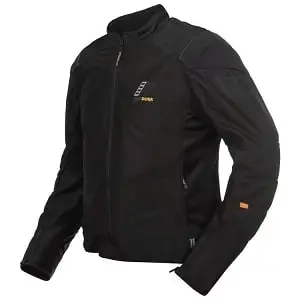Rukka designed this jacket using an open weave Cordura AFT mesh that aims to maximize airflow while retaining the abrasion resistance of standard Cordura fabric.
The StretchAir will compete directly with mesh jackets like the Klim Induction Pro, Revit Airwave 3, and the Dainese Super Speed Tex Jacket.
Below, I’ll share my hands-on impressions after extensively testing the StretchAir this summer. I’ll break down how it performed in key categories like comfort, protection, construction quality, and value.
But, the main question I will answer in this review will be: Is this the best motorcycle jacket for the summer for you? Let’s find out!
Rukka StretchAir Jacket

Key Takeaways
- The waterproof layer is sold separately
- Cordura mesh balances airflow, durability
- Lightweight, ventilated CE armor included
A Lightweight Summer Design with Cordura Abrasion Protection
The defining feature of the StretchAir is its Cordura AFT knitted mesh outer shell. Rukka engineered this fabric to be more open and airy than standard Cordura while retaining abrasion resistance.
In my experience, the jacket flows noticeably more air than a typical textile riding jacket. However, the ventilation could be more generous than some competitors like the Revit Airwave 3 with its highly perforated polyester outer shell.
The tradeoff is that the StretchAir should prove more durable over time compared to jackets lacking any abrasion-resistant material.
This elevated tear and abrasion resistance provides peace of mind during city riding or highway commutes, where you’re more likely to brush up against objects.
Reinforced Shoulders and Elbows For Enhanced Protection
Rukka reinforced the StretchAir shell in key impact zones with an extra layer of Cordura on the shoulders and elbows. This bolsters protection while maintaining good airflow in these crucial areas.
The shoulders are reinforced with an additional strip of Cordura fabric, while the elbows receive sturdy panels. The reinforcement is noticeable when wearing the jacket and examining its construction.
Lightweight and Airy CE Level 2 Armor
Keeping cool was also a priority in the StretchAir’s armor design. It comes equipped with a lightweight set of Rukka D3O Air XTR shoulder and elbow protectors.
These ventilated pads are certified to the CE Level 2 impact standard, allowing air to pass through. I found they didn’t restrict movement or cause discomfort, even on hot days.
You can upgrade the StretchAir with optional Rukka D3O Air chest and back inserts for additional protection. The jacket is prepped for these upgrades with compartments ready to accept the protectors.
Armor Protection
- Shoulders: Rukka D3O Air XTR (CE Level 2)
- Elbows: Rukka D3O Air XTR (CE Level 2)
- Optional Upgrades:
- Chest: Rukka D3O Air Chest Inserts
- Back: Rukka D3O Air All Back Protector
A Comfortable, Multi-Season Fit
Rukka designed the StretchAir for use in both warm and cooler conditions. It achieves this versatility through excellent adjustability and compatible layering pieces.
Several adjustment features allow you to customize the fit:
- Waist adjustment tabs with Velcro closures
- Bicep zippers to expand sleeve width
- A connection zipper to attach Rukka riding pants
The jacket also incorporates stretch fabric panels in the lower back and underarms. This combination of adjustments and flexibility accommodates different body types and makes pulling the jacket on and off easier.
For colder weather, the StretchAir was designed specifically to pair with Rukka’s StretchDry jacket. This separately sold outer shell zips onto the StretchAir to provide waterproofing and insulation.
The StretchAir works across a wide temperature range thanks to its airflow and versatility. Adding the StretchDry shell expands this into a true 3-season jacket.
Convenient Storage and Weather Protection
The StretchAir includes several handy storage and weather protection features:
- Two zippered front pockets
- One left chest pocket with a water-resistant lining
- A soft microfiber lining across the inner surface
The microfiber lining wicks moisture and prevents the jacket from sticking to your skin when you sweat. And the water-resistant pocket keeps small essentials like phones dry.
Airflow Where You Need It Most
Now, let’s discuss the StretchAir’s ventilation and airflow since that’s the entire premise of this jacket.
The open-weave Cordura fabric succeeds in allowing noticeably more air to pass through than solid textiles. Air channels can be felt inside the jacket.
Ventilation is further enhanced by:
- Mesh lining the jacket interior
- Perforated armor
- Cutaway armpit panels lined with mesh
This combination enables effective airflow across the core and arms. The jacket flows air evenly rather than just pushing it through a few inlet vents.
By design, the most ventilation occurs across the torso and back. This aligns with the high heat and sweat zones for many riders.
Armpit perforations add supplementary venting through a highly aerodynamic zone. Hot air can escape laterally out the sides of the jacket.
Waterproof Outer Shell Sold Separately
As mentioned earlier, Rukka offers the companion StretchDry jacket as an optional extra. This 2-layer waterproof and breathable shell zips onto the StretchAir to add foul weather capabilities.
Some riders will appreciate having the ability to convert the StretchAir into a 4-season jacket with the StretchDry. However, others may need to improve at spending extra.
The Revit Eclipse jacket combines waterproofing with a removable thermal liner for a similar price. And some mesh jacket options come fully waterproofed from the start.
Balancing Airflow and Abrasion Protection
After extensive testing, it became clear the StretchAir hits a sweet spot between airflow and durability. The Cordura mesh flows noticeably more air than standard textile while retaining abrasion resistance.
It offers a solid step up in ventilation compared to textile jackets. However, mesh options like the Airwave 3 provide even greater airflow through their highly perforated shells.
The upside is that Cordura mesh holds up better against scrapes and road rash. So you get enhanced commutes and urban riding protection compared to those jackets.
Super mesh jackets win out for maximum ventilation for hot weather and high-exertion riding. But they trade off durability that could be beneficial in certain riding contexts.
The StretchAir provides a nicely balanced option as a warm-weather jacket. Let’s now see how it stacks up on value.
Is the StretchAir Worth the Price?
At a retail cost of circa $499 USD, the Rukka StretchAir is a mid-range summer jacket option. Based on my testing, here is how I would assess its value:
- Construction Quality – The jacket features excellent quality materials and armor. The Cordura fabric, stitching, and seam workmanship are all impressive.
- Comfort – A comfortable fit with useful adjustments. The panels and armor don’t restrict movement or cause pressure points.
- Airflow – Very good airflow that beats standard textile jackets but isn’t as airy as perforated mesh.
- Weather Protection – Minimal. On its own, it lacks waterproofing and insulation.
- Safety – Provides good impact protection across the shoulders, elbows, chest, and back optionally. Abrasion protection is elevated.
Considering these factors, the StretchAir is priced appropriately for its features and performance. Serious summer riders may want to compare it against mesh jackets, which could offer greater airflow or weather protection within the same price range.
Frequently Asked Questions
What kind of weather is the StretchAir jacket suitable for?
The StretchAir works great as a warm/hot weather jacket. It provides plenty of airflow from about 50°F up to very hot temps exceeding 100°F. However, it lacks waterproofing for wet conditions. Rukka’s StretchDry jacket can be added for rain protection.
How durable is the Cordura mesh fabric compared to standard textiles?
The Cordura AFT mesh is abrasion-resistant like regular Cordura but flows more air. It should hold up well to scrapes, unlike bare mesh jackets. Areas with standard Cordura reinforcement add further durability.
What type of riding is the StretchAir ideal for?
It’s a fantastic jacket for aggressive canyon/sport riding in warm weather where you need a balance of airflow and protection. The Cordura shell offers more abrasion resistance than perforated mesh for demanding rides. Commuters will also appreciate the jacket’s ability to block wind compared to mesh.
Does the jacket run true to size?
Yes, the StretchAir fits according to standard sizing. I recommend trying it on in person, but generally, you can order your normal size. It includes several adjustments as well.
Is the StretchAir a standalone summer jacket, or does it need the StretchDry layer?
The StretchAir functions great on its own in warm and hot conditions. The StretchDry shell is only needed if you require waterproofing for rainy riding. It’s not mandatory but provides 3-season versatility when paired together.
Final Thoughts
Is this the best motorcycle jacket for the summer? After extensively testing the Rukka StretchAir this summer, I’ve been impressed with how it balances airflow and protection.
The Cordura mesh outer shell proved durable and abrasion-resistant without overly sacrificing ventilation.
Riders who want a warm weather jacket with enhanced airflow and good safety for aggressive riding should strongly consider the StretchAir.
I would recommend trying it on before buying, but the fit and construction quality are excellent.
The lack of included waterproofing does limit the StretchAir’s viability for year-round use. However, the available StretchDry shell addresses this for riders willing to pay extra.
At around $499 USD, the StretchAir hits a reasonable price point, given its performance and features. Take a look at mesh and waterproof jacket options as well to make sure they align with your needs and budget.
But overall, the StretchAir delivers impressive capabilities for warm-weather motorcycling.
Previous Article: Scorpion Vortex Air Jacket Review
Next Article: Sedici Alexi 2 Mesh Jacket Review

